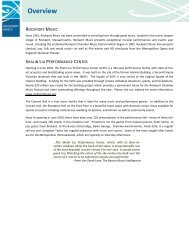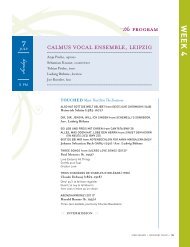Create successful ePaper yourself
Turn your PDF publications into a flip-book with our unique Google optimized e-Paper software.
<strong>Notes</strong>on theprogrambySandra Hyslopreferred to his new C major Piano Trio as “one of my finest works.” Coming from Brahms,who had become notorious for his exceeding self-criticism, these expressions of confidenceare as startling as they were rare.In summer 1880 Brahms had begun composing the C major Piano Trio in Bad Ischlduring his annual working vacation. Putting it aside while he completed other major works,he finished it in August 1882 and performed it privately for friends in Bad Ischl. Simrockpublished the Trio later that year as Opus 87. Its first public performance took place inFrankfurt-am-Main on December 29, 1882. Brahms himself was at the piano, with colleaguesFriedrich Hermann, violin, and Wilhelm Müller, cello.The Piano Trio in C major is justly noted not only for its beauties, apparent already on a firsthearing, but also for its masterful construction. The grand first movement opens with theviolin and cello playing an expansive main theme in unison. The piano contributes a stepwisesecondary theme, and the strings join in for a third principal melody. Brahms worksthese themes into a concise sonata form, with the strings frequently playing together asa complement to the strength of the piano. The movement ends with an extended coda.For the second movement, predominately in A minor, Brahms chooses one of his favoritestructures, a theme and variations. This is one of his most sophisticated and successful inthat form. The strings play the melancholy main theme, which has the character of anEastern European folk song, while the piano plays offbeat accompanying chords. In the fivevariations Brahms alternates between working with the strings’ initial melody and developingthe offbeat piano accompaniment.The scampering main themes of the Scherzo, in C minor, demand technical fluency from allthree instruments and from the ensemble, which must maintain crisp delicacy in the outerportions of the movement. The inner Trio creates gentle repose, with a burst of sunny optimismfrom the piano, before returning to the scampering conclusion. The Scherzo endswith a C major whisk that predicts the return of the tonic key in the final movement.The Finale, Allegro giocoso, turns the scampering of the Scherzo into an all-out instrumentalrace of good-humored themes. But for a short contemplative oasis toward the conclusion,the Finale is a flashy display of virtuosity.64 :: NOTES ON THE PROGRAM





